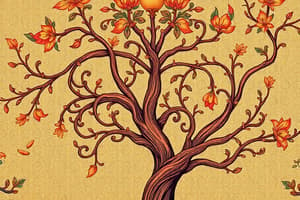Podcast
Questions and Answers
What is the primary function of a decision tree in business decision-making?
What is the primary function of a decision tree in business decision-making?
- To visualize employee performance metrics.
- To trace alternative outcomes and compare profitability of options. (correct)
- To evaluate market trends and consumer feedback.
- To provide qualitative analysis of a product's success.
Which of the following is NOT a limitation of using decision trees?
Which of the following is NOT a limitation of using decision trees?
- They can illustrate multiple outcomes effectively. (correct)
- They may lead to biased results if probabilities are misestimated.
- They require accurate historical data to be effective.
- They may oversimplify complex decisions.
In the structure of a decision tree, what does a square represent?
In the structure of a decision tree, what does a square represent?
- A financial outcome.
- A decision point. (correct)
- A probability event.
- An end point of a decision.
What aspect is critical for ensuring the accuracy of a decision tree's predictions?
What aspect is critical for ensuring the accuracy of a decision tree's predictions?
Which decision-making strategy is suggested when multiple options with varying outcomes are available?
Which decision-making strategy is suggested when multiple options with varying outcomes are available?
Flashcards are hidden until you start studying
Study Notes
Decision Trees Overview
- Decision trees are tools used for analyzing the potential outcomes of decisions in a business context.
- They help visualize different courses of action and associated probabilities, enabling businesses to make informed choices.
Constructing and Interpreting Decision Trees
- Start with a decision point represented as a square, indicating a decision needs to be made.
- Add multiple choice paths (branches) that represent different strategies, such as launching a new product or initiating a marketing campaign.
- Each decision can lead to various possible outcomes, represented as 'chance nodes' linked to probabilities of occurrence.
Functionality of Decision Trees
- They provide a quantitative framework by using historical data to predict the likelihood of success for each option.
- Expected Value (EV) is calculated for each path, informing design and engineering decisions based on market reactions.
Application of Decision Trees
- Useful for businesses like Toyota to estimate financial implications from decisions (e.g., costs associated with product recalls).
- Financial outcomes derived from decision trees can be effectively communicated to stakeholders, aiding in rational decision-making.
Limitations of Decision Trees
- The reliance on estimated probabilities and outcomes may not account for the dynamic nature of business environments.
- External factors can result in previously predicted figures becoming outdated, affecting decision accuracy.
- Implementation of decision trees can be time-consuming, with potential time lags leading to outdated information at the decision-making stage.
Key Benefits of Decision Trees
- Provide a clear visual representation of complex decisions, facilitating better understanding of possible outcomes.
- Allow businesses to quantify and compare financial impacts of various strategies, resulting in informed decision-making.
Studying That Suits You
Use AI to generate personalized quizzes and flashcards to suit your learning preferences.




